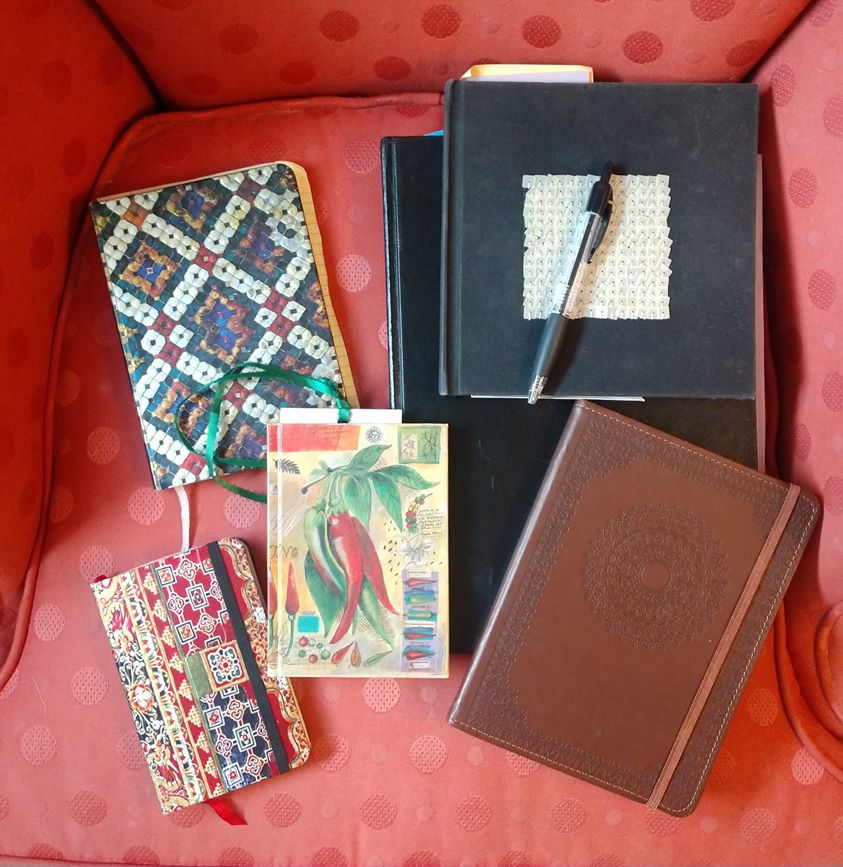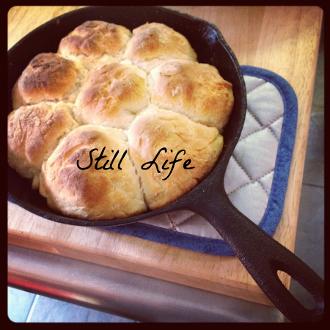We invited writers, artists, and musicians to share a favorite creative prompt or craft lesson, or to tell us about a book, poem, song, or film that affected them. We asked them to offer opinions and experiences on creativity, artistic processes, and the role of arts in culture. We're offering their responses here as occasional features on creativity that we're calling Still Life.
For this edition of Still Life, we asked Elaine Neil Orr to expand on a social media post she shared during summer, 2020, as the coronavirus pandemic kept most of us shuttered and sheltered in place. Her post was about the various types of journals she uses and how choosing “the right canvas” can facilitate various forms of writing and journal-keeping. (The photo below illustrates just a few of the author's various journals.)
Elaine Neil Orr is the author of five books, including her memoir Gods of Noonday: A White Girl’s African Life (Univ. of Virginia Press) and two novels, A Different Sun: A Novel of Africa and Swimming Between Worlds (Berkley/Penguin/Random House, 2013, 2018). Swimming Between Worlds was called by the Richmond Times-Dispatch “a novel of great humanity . . . It scores a triumph for its author and a blessing for her readers.” It was also a finalist for the Phillip H. McMath Post-Publication Book Award. Orr has published widely in literary journals, including Image, Blackbird, The Missouri Review, storySouth, and Still: The Journal, among others. She is Professor of English at North Carolina State University and teaches in the Brief-Residency MFA in Writing Program at Spalding University. Find her on Twitter @elaineneilorr.
For writers, no writing is ever really lost. Everything you write remains somewhere: if not in a published book then in a journal and if not in your journal, then somewhere in your brain. And the more you write, the more writing comes to you, whether through memory or by invention. I have found little pocket-size notebooks I’ve kept for years wedged in drawers or dropped behind larger books on a shelf. I can pick one up and turn to a page randomly and find an idea–often a good idea–and pick up the thread. Recently, I was looking for an additional short memoir to add to a collection. I went trolling through my (very unorganized computer files) and, of course, I found one, nearly finished, but for some reason (a fast-approaching deadline to copy-edit a novel, produce a syllabus?) left unfinished. I fished that essay right out of there and with a little work I had what I needed.
It is especially important to keep writing when you can’t be WRITING, when you can’t devote months to the BOOK, but are living in the thickness of responsibilities that pull your mind and energy to your job or children or aging parents or your own health crisis. I have known several health crises in my adult life. In a period when I was doing dialysis and my energy was low, I wrote in large floppy journals, looking out from my living room onto a dogwood tree. I wrote through several seasons watching that tree move from flower to green leaf to orange fall to winter berries and around again. The journals had beautiful art on the cover and I used lovely pens I purchased just for this exercise, because I needed beauty, and I needed to write. When I received two new organs, I went back to those six, full-to-the-brim journals and excavated for my memoir, my first book of creative writing. Everything was already there, a treasure trove.
In other seasons, I have kept lists of verbs gleaned from poetry books in pocket size journals because poetry possesses more strong verbs per line than any other genre. This activity is akin to another habit I have of picking up stones. A bowl of stones keeps me grounded. A list of verbs in a pocket journal helps me fly because verbs are the part of speech with the most power to lift us out of sluggish writing. You might say I am just copying when I transfer verbs onto a page. No. I’m writing. I’m wresting those words out of their present location and making them mine. And when I hand write, I’m also etching the verb/word into my brain.
I’m all for copying sentence types. I love to find a beautiful sentence in someone else’s novel and make one of my own just like it. I write these as exercises in whatever journal comes to hand. I suppose it’s a practice like singing scales if your voice is your instrument. All of this writing accrues. It all counts. It’s all yours or mine.
I have written essays by writing one or two paragraphs a day in a journal, in the morning, over a period of three or four months. When I can finally find a week to devote to it, I pull those paragraphs out of my journals, key them into a new Word document, move them around, and stitch them together. I have published five essays in five years using this method, along with publishing a novel. What blocks of time I had, I devoted to the BOOK. What snatches of time I had, I devoted to essay-by-paragraph writing.
At moments, when I have longed to be in THE BOOK but didn’t have the time or attention it required, I have invented conversations or musings for my characters in a separate file on my computer, not because I think I will use these bits of writing but because I need to keep the characters alive, off-stage. And sometimes I excavate those files much later and find something I can use, even if it’s just a sentence, or a thought that leads to another thought.
I write the names of people I love and am praying for in my journals and circle the names in bands of color from a special set of colored pencils. This, too, is writing. I have even written grocery lists and to-do lists in my most prized journals just so I can be in that book of makings, as in a sacred space, a chamber in a church, or a garden with a labyrinth. As yet, I have not incorporated one of my grocery lists into a novel, but the day will come, I assure you, when my protagonist will go to the store as I will go today to purchase a birthday cake, dog food, sunflowers, eggs, and butter.
What we must not fall for is the idea that because our writing life doesn’t look like someone else’s—someone who has more time, who appears to have fewer responsibilities, who publishes more—we can’t write. We can. Even if it’s a sentence. Even if it’s three words. Even if it’s copying. Even if it’s undertaken while sitting in a cubby in a skimpy paper gown waiting for a mammogram. That’s actually a very good place to write.
The thing is to be writing all the time. In parking lots, in a workshop you are leading, in church (one of the best places I’ve found), at the museum, at a child’s soccer practice, by the lake, in your backyard. I don’t suggest writing while driving though I’ve been known to write at a stop light. Write in a large notebook and chances are you won’t lose it.
I hope you understand that I am talking about something physical and metaphysical. There are the actual words on the page. If you keep them, you have them. You have notes about your dream life, a conversation overheard at a restaurant, a description of a yellow gingko tree in late October, a list of all of your characters’ names and who knew what when, a sentence spoken by your granddaughter. But there is also the intangible, curled in your brain: the beautiful rhythm of two or three words next to each other that you have composed, the passages from someone else’s writing you copied down. All of this is you and yours. It rests just below the surface like your beating heart. At any moment, almost anywhere, you can access it. In the terms of this blog, your published work is no different from your unpublished work. It is all coming to you, like a brilliant season of light.
Visit the archives of Still Life features

_____________________________________________
Home Archives Fiction Poetry Creative Nonfiction Interview Still Life
Featured Artist Reviews Multimedia Contest Masthead Submit Feedback
_____________________________________________
